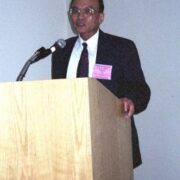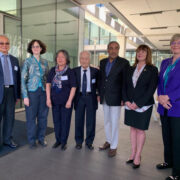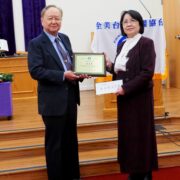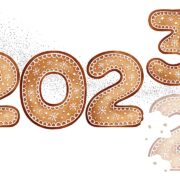Dreaming for a New Renaissance
Author: Tsing-Fang Chen
My name is Tsing-Fang Chen, (T. S. Chen). I was born in 1936 in Guiren Township, Tainan county. I‘ve loved art ever since I was little, and it was in my second year of middle school when I first encountered Western modern art. I was especially moved by the works of Van Gough, so much that I resolved to move to Paris to become a painter! In my third year of middle school I drew sketches at the Taiwan Fine Arts Association (台湾南美會); Kuo Pochuan, Chang Changhua and Hsieh Kuoyung were all teachers that greatly inspired me.
Every weekend, as well as summer and winter vacations, everywhere I went I would draw. I was also interested in literature. After Tainan First Middle School, I was specially recommended for admission (without taking the required entrance exam) to high school, and later, at the foreign languages department of National Taiwan University (NTU). During my university years, I spent half of my time drawing. I also served as the club head of NTU Art Society and partook in an art exhibition at Zhongshan Hall. Then, in 1963, I applied for a scholarship from the French government; of the 600 applicants, I was one of only two who were accepted. So, I borrowed 100USD from my friend Tsunglin Chen (a teacher at Tainan First Middle School) to go to Paris. That was the beginning of my 12 year stay in Paris.
I got my master’s degree at the University of Paris, and in 1970 I completed my Ph.D. in art history. During these 7 years I also created many works at the Paris Art Institute. At the time, I was perhaps the first artist to receive a Ph.D. My thesis was 600 pages long, and my professor only changed one word before giving me top marks. I spent one year writing my theses, titled: Chinese Calligraphy and Contemporary Painting (中國書法與當代繪畫). I proposed the Japanese Ukiyo-e movement influenced the Western impressionists, and that Chinese calligraphy influenced the lyric branch of the abstractionist school. I examined the East-West cultural exchange, and compared similarities and differences of Western and Eastern culture. Through this I developed the idea of “five-dimensional world culture. “This view of culture became the foundation for my branch of Neo-Iconography. In the art world, it is quite rare for an artist to propose a new theory, more so to be a founder of a new branch of art. The chapter on globalism in American University’s book Art and Ideas, widely used as a textbook for world art history, specifically introduced me and my works. I was the only artist introduced in that chapter.
My 12 years in Paris were difficult; I had to work part time to cover my bills. However, during my Paris years I held 8 exhibitions, translated the world-famous novel A Little Prince, wrote articles to be sent back to Taiwanese magazines, and published Paintings of Paris (巴黎畫 誌), Ten Years of Painting (畫遊十年), and Winding Corridor (回廊). My diary of over 1600 pages, “My days in Paris,” became an important reference document for researchers of society and culture in 1960s Paris.
My Neo-Iconographic school was taken up by the social tide of the time, paving the road for a series of celebrated works (1985-2011). First was the Spirit of Liberty series in 1986, which received special reports from CNN and the New York Times; the New York Times celebration host even visited the exhibition in person added a piece to their collection. Next came the Eiffel Tower series (1989), and then the 1990 Post Van Gough series, which was displayed in Amsterdam simultaneously with the works of Van Gough himself. One work, The Return of Van Gough, was printed full spread in the book The Mysteries of Van Gough published by Asahi TV. And the former cultural minister of the Netherlands Dr. Hosk, an expert on Van Gough, called me, “Van Gough’s successor.” Following this was the Princess Diana series (1997). During the 2008 Beijing Olympics I created the Olympics series; these 66 works were displayed in five different exhibitions in Beijing and printed in a new 300-page book. In 2010, at an age of 75, I completed the Shanghai World Expo themed series of works in 184 days; this was a deeply meaningful challenge. At the World Expo I was interviewed by over 80 different media, including China Central Television and the World Expo News Center. I was known as “the star of the World Expo,” and was invited to the World Expo Industrial Park to complete the 100th painting and a solo exhibition, becoming the first in the 159-year history of the World Expo. That series of works has become a precious cultural heritage for the World Expo. These celebrated works have received much media attention, and become the primary content for the “Art for Humanity World Tour Exhibition,” jointly launched by myself and the United Nations (UN), also including the Taiwan Flowers series of works and exhibits.
The year I received an invitation from the Ceramics Institute in Jingde County of Jiangxi province, China, to create large-scale (1x 2 meter) porcelain platters of representative works from the Beijing Olympics and Shanghai World Expo series. UNESCO officials made a special trip to Jingde from Paris to view it. This series of works has been called the largest scale modern porcelain art series in history; in total there are two sets of eighty works each collected by Jiangxi Jingde Ceramics Institute and the T.S. Chen Cultural Center in New York City.
In response to the Bringing World Peace through Travel initiative initiated by the UN, I launched the “Cultural Travel Series”. Last year, the government of Hainan province in China invited me to create works inspired by local material, and in April we held a ceremonious gallery at a museum.
My whole life I have seldom applied for rewards. I recall when I received the UN World Tolerance Award (implemented by Friends of the UN) in 2001, some people would ask, “How do you apply for this award? Which painting received the award?” What I thought was, if this award required application I certainly would not have won it. When Friends of the UN notified me of the award, I recommended Tzu Chi to them and contacted my former classmate at Tainan First Middle School Dr. Li Mingte, who was president of Tzuchi Medical University at the time, to ask for English materials. Later, Friends of the UN informed me they do not accept recommendations, much less applications. They selectively pick from artists worldwide, who they observe closely for many years. The board of directors then discusses criteria such as the artist’s influence and contribution in their respective artistic and academic fields, and their contribution to society, to make a comprehensive decision. At the awards ceremony, I was specially appointed as a “cultural ambassador,” and I took on my mission: the “Art for Humanity World Tour Exhibition”.
In his letter Dr Brown wrote:
“In deciding to present this award to you, our board of directors is deeply impressed by your multicultural works, as well as your life-long dedication to peace, tolerance and love, and your numerous creations expressing a common aspiration for humanity. In a time when the globe is rapidly changing and tensions are rising, everyone is searching for a way to respond. We feel that mobilizing artists to work towards peace and harmony between ethnic groups is more urgent than ever. Therefore, Friends of the UN is eager to organize ‘world-wide art for promoting peace and tolerance’ exhibitions with you. For this reason we appoint you, as the winner of this year’s award, as an ‘ambassador of peace and tolerance,’ and hope you will continue to support the UN in this line of work.” The awards ceremony was held on December 11th, 2001, at the United Nations Headquarters in New York City. Speaking to an audience of nearly 400 guests, in my acceptance speech I mentioned the challenge ahead:
“Art can be used to change the world, and to unify humanity. The United Nations has already been actively using art, culture, religion and other humanities to collectively work towards world peace and harmony. These profoundly valuable fields can become a powerful force which can influence politics, economics, and military affairs. In today’s high-tech world, in addition to ‘hardware’ and ‘software, ‘we should also cultivate ‘soulware,’and embrace the spirit of globalism. I deeply believe in the vision of the priest Teilhard de Chardin (1881-1955). He said, ‘Love is the true soul of this world, and after the era of matter we enter the era of love.’ I am pleased that my Neo-Iconography, an art form for humanity, can be used to further this profound vision.”
I was born and educated in Taiwan, and conducted research in Paris for 12 years. In 1975, I left France, and in 1983, I became a citizen of the United States. Having been influenced by the three continents of Asia, Europe, and America, I have grown to have the consciousness of a “world citizen.” In the “global village” of today, this kind of consciousness is gradually becoming more common and is worth encouraging. Anyone can cultivate this kind of consciousness, which can be further integrated into a world culture founded in friendship, peace and tolerance. Along these lines, any conscientious individual can become a potential member of “Friends of the UN,”and can partake in the great task of transforming the world and bringing fortune to humankind.
The opportunity I have to devote myself, my art and my foundation (as well as the experienced team of T.S. Chen Cultural Center) in service to this lofty goal is deeply impressed upon me. So I will continue the project of “Art for Humanity World Tour Exhibition” to promote art education and a world culture of “love, tolerance and peace.” May my art exhibitions around the world glorify my motherland, Taiwan!
My expectations towards Taiwan: Taiwan is the cradle of the new Renaissance. When I visited the birth site of the Western Renaissance – Florence, Italy – I realized all of humankind needs a new Renaissance, and that Taiwan will be its cradle!
My creation of the Neo-Iconographic school is really a new form of expression; it transcends culture, space and time, and cleverly combines and interweaves well-known images, recombining them into a bold artform. Furthermore, each work contains a hidden cultural mission: a global New Renaissance based in love, each harboring grand scale thought and a sentiment of care. I feel that humankind already shares a collective fate; the world has already become a “global village.”All people should position themselves as “global citizens”and advance the spirit of world unity and world peace. What I mean by the fifth dimension is “love.” In addition to hardware and software, we should also cultivate “soulware,”and embrace the spirit of globalism. Taiwan is full of talent and vitality. In the past 400 years, it has become a point of intersection for Western and Eastern culture, integrating cultures ancient and modern, Chinese and foreign. A cradle for the New Renaissance needs to sit at the crossroads of East and West, and Taiwan is just at the intersection of Eastern and Western culture. Progress also necessitates a sense of urgency. The Taiwanese are an immigrant peoples; they are adventurous by nature. They also place high importance on education, and are intelligent and capable, hardworking and industrious. Perhaps in military and economic matters Taiwan cannot compete with major powers, but in terms of culture Taiwan is a glowing light on the world stage.
In 1975 I moved from Paris to New York City. In 2011, Taiwan Business Weekly published my biography, World Dreams of a Taiwanese Youth (台灣少年世界夢). As put my this biography, “Tsing-Fang Chen speaks out for Taiwan using art, and advocates for a New Renaissance. Art transcends borders and politics. Besides being a source of beauty, art can also have the power to unify humanity, transform society, and rehabilitate our spirits.” From 1984 to 2003, I completed 4 exhibition tours in Taiwan, each time for one to three years. Promoting art education and spiritual rehabilitation, we called it Culture to the Countryside (文化下鄉). We also held charity sales of art for the “Art for Humanity World Exhibition Tour,” spreading the consensus of the new century – love, tolerance and peace – to all parts of the world. I feel that in today’s highly politicized Taiwanese society, we need to settle down before we can move forwards. Everyone should respect and show tolerance towards each other; this common contribution to Taiwan transcends political affiliation.
Looking back on my life, it has been at once difficult and fulfilling. In the past half century I’ve steadfastly pursued my dream, I’ve created thousands of works of art, published 26 books, and given over 200 lectures all around the world. My thoughts and artwork are introduced in over 300 textbooks in 33 different countries, and while I still live I have witnessed my own artwork included in art history books. The great integration of Eastern and Western culture, a global family, that I envisioned in the 60s has become the trend of the present era. My life has been exceptional in many ways.
Artists are blessed by nature with acute sensibilities and creativity. Therefore, artists should take on the responsibility of furthering societal and cultural progress. I feel my greatest contribution to Taiwan, and to the world, is my ideological and artistic works. I believe this is amongst the collective properties of humanity, and as such we have established the non-profit organization T.F. Chen Cultural Center (陳錦芳文化館) to preserve, organize and employ it, and to initiate dialogue with art museums around the world. My greatest regret is that I have a multimillion-dollar T.F. Chen Art Building in New York in my name, but have none in my beloved Taiwan. So, we have decided to return to the roots, and construct a landmark art museum combined with an art hotel for creative industries. We have 40 years of experience in creative industries in Europe, Asia, and the Americas, and we hope to enrich and diversify the arts and culture environment of Taiwan. The planned T.F. Chen Art Museum (陳錦芳美術館) will feature a center for international exchange, as well as an international arts education center and an international creative industries center.
We will collect hundreds of millions of dollars’ worth of art collections, and will sell my works to build an art hotel and guest house that can be used for cultural and creative ends. The art museum is designed to be built inside this hotel; it is estimated that it will create a lot of employment opportunities in Taiwan, as well as further social education and cultural diplomacy. I hope to build an art museum for Taiwan that develops locally and spreads internationally.
I’ve already reached the ripe age of 77. Building an art museum not only requires special hardware and rich and reputable software, it also requires “soulware.”In addition to manpower, material resources, financial resources, support, planning and location, building a museum also requires many years of time. I want to extend my gratitude to my alma matter for cultivating me and to my close friends for encouraging me, especially my wife Lucia Ho Chen, who has shared all my joys and hardships these past 40 years. All events have been facilitated by her and our team so that I can concentrate on my art. I hold Lucia Ho Chen in high esteem. She is knowledgeable, experienced and wise; she is a woman of courage, perseverance and an entrepreneurial spirit, while also having such traditional virtues as being hardworking and frugal, putting her husband first, respecting elders, caring for the family and showing love for the homeland. These past 40 years she has taken care of all things practical, and made me see the strong and noble side of Taiwanese women. She specializes in art brokerage, creative publishing, investment and collections. She is the chairman or president of numerous companies, and is among a minority of Asian women in the United States who organizes a non-profit related to arts and culture. When I was 28 years old, I was inspired by the Italian birthplace of the Renaissance, and resolved to facilitate the role of Taiwan as the cradle of a New Renaissance for humanity. Though I have strived towards this goal my whole life, I am only human. My ability has limits and so this ideal has not yet been realized. So, I hope to construct a landmark art museum combined with an art hotel for creative industries in Taiwan, a cultural center which will be promoted for generations to come.
Translated from 90. 我, 夢向新文藝復興 / 陳錦芳 by Sky Ford
Posted Sept 2020
Source: Tsing-Fang Chen





